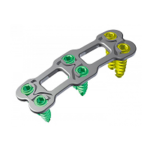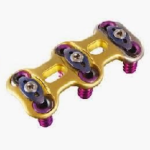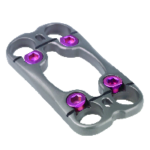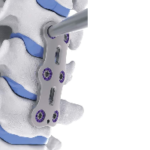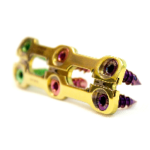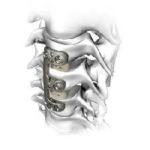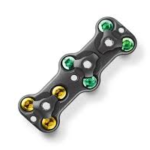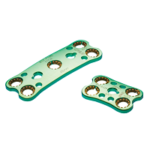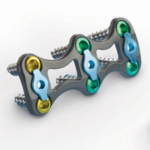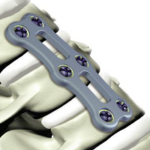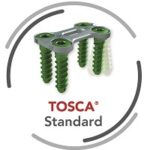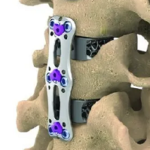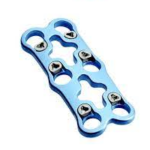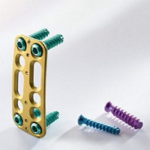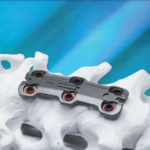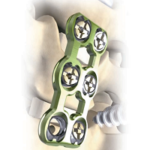uNitas™ is a cervical plate system for the anterior stabilization of the cervical spine with automatic back-out mechanism and option of four types of screws:Bone screw, self drilling: diameter of 4 mm for monocortical fixation available in four different lengths ;Bone screw, self tapping: diameter of 4 mm also for bicortical fixation available in seven different lengths ;Bone … [Read more...] about uNitas™ anterior cervical plate system
Anterior Cervical Plates
osmium™anterior cervical plate system
Osmium is a cervical plate system for the anterior stabilization of the vertebral column. The implant immobilizes the fusion mass until the bone graft has consolidated.The special feature of this system is the monocortical fixation with osmium screws. The osmium screw, consisting of a screw and a bolt, is expanded when the bolt is inserted.The expansion mechanism makes superior … [Read more...] about osmium™anterior cervical plate system
Reliant™ Anterior Cervical Plating System
The Reliant® Anterior Cervical Plating (ACP) System simplifies anterior cervical spinal fusion with an improved semi-constrained system that offers fast, reproducible results. The Reliant ACP System’s engineering excellence features a sleek, ultra-thin plate for easy insertion and large plate slots for enhanced visual confirmation of the allograft. The instrumentation … [Read more...] about Reliant™ Anterior Cervical Plating System
PROVIDENCE™
PROVIDENCE™ is an anterior cervical plate with large windows that allow graft access and visualization. The technologically advanced screw blocking mechanism provides audible, tactile and visual confirmation of locking. Features: Advanced Blocking Mechanism: Provides confirmation that the screws are blocked in place.Large Window:Allows for visualization of graft placement … [Read more...] about PROVIDENCE™
HERO Anterior Plate System
The anterior cervical plate system HERO® provides stability to the cervical spine following anterior-cervical spine fusion procedures.The system is suited as a stabilization of cervical spine from C2 to C7 with a uni- or bicordical fixation of the screws at the anterior side of vertebral body.The Expansion Screws provides excellent purchase with monocortical anchorage even in … [Read more...] about HERO Anterior Plate System
SmartLox™ Anterior Cervical Plate
Designed in collaboration with a practicing spine surgeon, the SmartLOX system provides an extensive selection of plate and screw variations and sizes. SmartLOX uses Captiva Spine’s patented locking device that you’ll see, hear, and feel as the fastener automatically locks securely into place. The NiTinol™ metal effectively eliminates the possibility of screws backing out of … [Read more...] about SmartLox™ Anterior Cervical Plate
VERTEVIEW Cervical Plate
The Verteview's Cervical Plating System's progressive design addresses the most common surgical challenges by providing excellent visualization, optimal load sharing, anatomical conformity, and construct integrity. Features: Unique plate geometry blends the biomechanical advantages of dynamic and static platingAnatomic contours along with a narrow width create a more … [Read more...] about VERTEVIEW Cervical Plate
Trinica Anterior Cervical Plate
The Trinica and Trinica Select Anterior Cervical Plate Systems are versatile spinal implant systems that provide a full range of plate and screw sizes to ensure a better anatomical fit with little or no contouring required. These anterior cervical plate systems are intended for anterior interbody screw fixation of the cervical spine, and feature the innovative Secure-Twist® … [Read more...] about Trinica Anterior Cervical Plate
ThinLine cervical plate
Zimmer Spine’s ThinLine cervical plate combines one of the industry’s lowest-profile designs with impressive strength and support. Featuring a lean, 1.8mm profile and a smooth, friction-reducing surface, the ThinLine plate is designed to help surgeons address dysphagia which is sometimes associated with discectomy and fusion procedures. This unique cervical plate also utilizes … [Read more...] about ThinLine cervical plate
inVIZia System
This innovative cervical plate system is designed for anterior interbody screw fixation of the cervical spine. The inVIZiaSystem features direct visualization of implant placement and screw locking for ease of use. With its generous graft window, low profile, simple locking mechanism, narrow waist, and aggressive self-drilling screws, it is a complete solution in one … [Read more...] about inVIZia System
The Reflex® Zero Profile ACP System
The Reflex® Zero Profile ACP System offers a selection of one- and two-level low profile anterior cervical plates. Used in conjunction with Reflex® Hybrid bone screws, the system can accommodate both semi-constrained and rigid bone screw fixation philosophies. The Ti-6Al-4V alloy plate has minimal material running sagittally through its center, thereby minimizing contact with … [Read more...] about The Reflex® Zero Profile ACP System
TOSCA ® Standard and Expansion Anterior Cervical Stabilization
In 2005, the first SIGNUS plate for anterior cervical stabilization was launched: TOSCA. It offers the user a high degree of flexibility for ventral stabilisation of C2 to C7. As of today there are two designs available – and at 1,6mm both are among the thinnest plates on the market. With the very thin plate design and the semi-rigid screw connection TOSCAStandard and TOSCA … [Read more...] about TOSCA ® Standard and Expansion Anterior Cervical Stabilization
ACDF Anterior Cervical Plate
The NuVasive anterior cervical plate (ACP) system is designed to achieve your ACDF surgical goals and help reduce dysphagia, malalignment and adjacent level ossification. ACP is procedurally integrated with versatile instrumentation, a complete interbody portfolio featuring advanced porous materials, traditional PEEK and allograft, biologics, the Maxcess C retractor and … [Read more...] about ACDF Anterior Cervical Plate
SKYLINE® Anterior Cervical Plate
The SKYLINE® Anterior Cervical Plate System provides a versatile system of implants and instruments to accommodate the needs and individual preferences of surgeons. The system offers optimal visualization, adapts to the anatomy of the patient, and instills the confidence afforded through proven technology. SKYLINE Anterior Plate-SGT.DePuySynthes.pdf Benefits: The SKYLINE … [Read more...] about SKYLINE® Anterior Cervical Plate
CASPARevolution Cervical Plate
DescriptionThe semi-rigid plate and screw interface is the basic priniciple of the CASPAR Cervical Plating System which has been used world-wide since 1980. Materials and design have been continously improved to reach the highest level of implant reliability. CASPARevolution is Aesculap's mature and safe cervical plating system. CASPARevolution-Brochure.BBraun Aesculap.pdf … [Read more...] about CASPARevolution Cervical Plate
VueLock™ Anterior Cervical Plate
One step locking mechanism featuring a pre-attached expansive ring design that eliminates the need for additional locking components. Vuelock-ACP-SGT.Zimmer-Biomet.pdf Benefits: Low profile plate minimizes interference with anatomical soft tissue structures. Unique, open design allows for intra-op visualization of the bone graft and end plates—as well as post-op … [Read more...] about VueLock™ Anterior Cervical Plate
C-Tek® Anterior Cervical Plate
The C-TEK Anterior Cervical Plate System consists of a variety of shapes and sizes of bone plates and screws manufactured from surgical implant grade titanium alloy as described by ASTM F 136 (Ti 6AI 4V ELI). The plates are provided in a fixed hole (C-TEK and C-TEK C-Thru) or slotted hole (C-TEK) design and are available in 1 to 5 level plates. The screws are supplied color … [Read more...] about C-Tek® Anterior Cervical Plate
MaxAn® System
The only anterior cervical plate with a design rationale to help minimize the risk of Adjacent Level Ossification (ALO)The design rationale of the MaxAn® System is based upon published papers on studies that found the incidence of ALO significantly decreases when the plate to disc distance is greater than 5mm from the adjacent level1,2. The MaxAn® System was designed to help … [Read more...] about MaxAn® System

